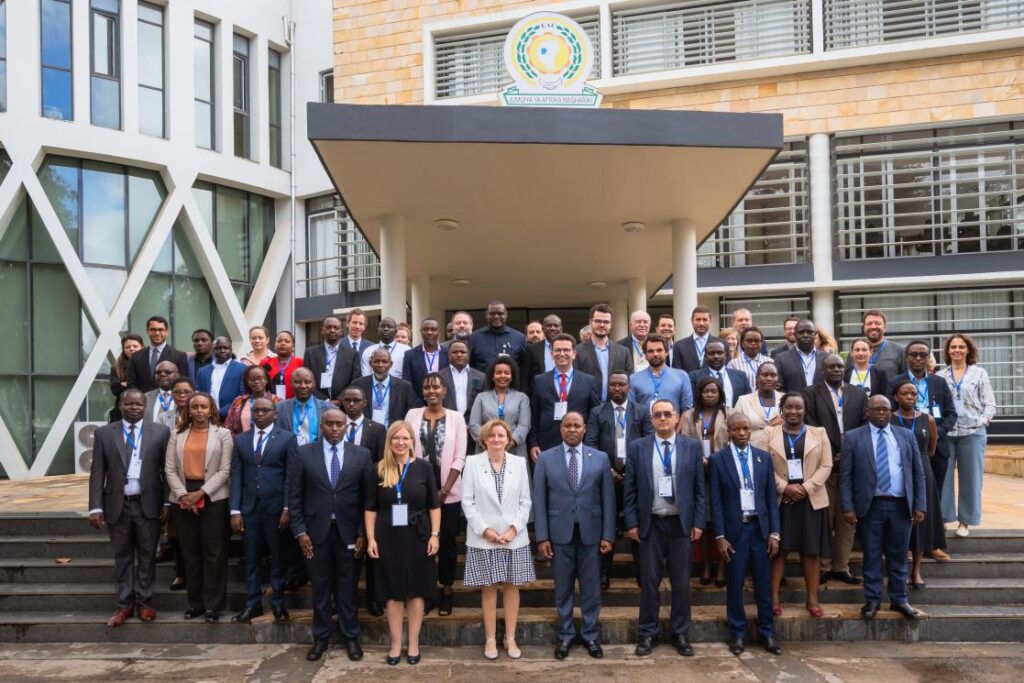- The EAC’s distribution sector is marred by systemic challenges, despite claims of a working free trade zone in the bloc.
- Stakeholders say that persistent bottlenecks hamper the flow of goods and services across the eight-member area.
- A recent EU-led EAC Peer-to-Peer Learning Conference sought to formulate a strategic action plan to address barriers limiting the industry’s growth and development.
The East African Community (EAC) is an eight-country strong regional free trade bloc in East Africa, by definition, it should mean easier movement or distribution of goods and services, but that’s only true on paper, the reality on the ground is quite on the contrary.
EAC maintains that it is “dedicated to enhancing economic efficiency and fostering regional integration through strategic investments and the utilization of established industries. The goal is to position the Community as a single investment area, harmonizing trade policies, investment incentives, and product standards.”
Protocols demand that the EAC Partner States prioritize regional trade integration as a cornerstone of their trade policies. By law; this involves strengthening both public institutions and private sector organizations engaged in export promotion, creating a conducive environment for cross-border trade.”
EAC partner states yet to enjoy benefits of a free trade zone
Yet, stakeholders are not enjoying the envisioned free trade zone even though “efficiency of this sector is crucial for ensuring that consumers have access to a wide variety of goods and services at competitive prices. Enhanced efficiency and competition in the distribution system can lead to lower prices, as distribution margins significantly affect final product prices and help reduce price distortions.”
These are the noble, views of the Deputy Director and Head of Regional Trade at Kenya’s State Department of Trade, Ms. Elizabeth Miguda. Delivering the keynote speech, the Head of Regional Trade insisted that “liberalization of this sub-sector (distribution) presents significant opportunities for new markets to enter the EAC.”
Miguda was speaking at the inaugural EAC Peer-to-Peer Learning Conference held in Nairobi, Kenya. Organized by the EU-EAC CORE programme, the conference stakeholders deliberated on key obstacles limiting the true potential of the distribution sector.
As stakeholders at the conference noted, there is a need to focus attention on regulatory frameworks, and growth strategies if the EAC distribution sub-sector is to achieve its potential. Currently, the EAC membership consists of eight states, including the Democratic Republic of the Congo (DRC), Somalia, Burundi, Kenya, Rwanda, South Sudan, Uganda and Tanzania.
According to a media statement released at the conference, a recent study on the region revealed that the distribution sector is marred by “restrictive investment laws which are impacting the entry and operations of wholesale and retail firms across EAC partner states.”
“The sector faces various issues such as fragmented regulatory obligations which lack any specific framework that would highlight and curb anti-competitive practices,” admitted the Head of Regional Trade at Kenya’s State Department of Trade.
“There is also a lack of business and management skills among entrepreneurs and insufficient digital skills to keep pace with the growing importance of online distribution channels,” she added.
According to her, streamlining the distribution process would, in effect, improve resource allocation, and improve the alignment of supply and demand.
“This will reduce risks, lower costs, enhance quality, and provide consumers with a wider range of products at competitive prices, thereby contributing to the sector’s overall efficiency,” she told stakeholders at the conference.
Inefficiencies in distribution systems
Seconding the view was Ms. Marie Angelique Umulisa, the Principal Trade Officer and Head of International Trade at the EAC Secretariat. “Distribution services account for approximately 20 per cent of global services trade and play a critical role in enhancing efficiency, quality and economic contributions across other sectors,” she noted.
Speaking on behalf of the EAC Secretary General, Ms. Veronica Nduva, the Principal Trade Officer and Head of International Trade at the EAC said distribution, in the EAC region, contributes between three and 10 per cent to GDP, making the sub-sector essential in economic development and employment.
“Liberalizing distribution services will enhance operational efficiency, create economies of scale, and offer consumers better pricing, quality, and a broader range of options,” she explained.
The diplomat added that; “it is only by addressing inefficiencies in distribution systems that consumers will fully benefit from the bloc’s liberalized trade.”
When in effect, the free trade goals would see ease in the distribution of products and services, particularly through reduced costs and increased product diversity, and in turn, the EAC would enjoy improved well-being, but challenges persist.
Solving distribution hurdles in the EAC
The EU-led EAC Peer-to-Peer Learning Conference sought to formulate a strategic action plan that can address barriers limiting the industry’s growth and development.
It drew stakeholders from the EAC wholesale trade services, retailers, and franchising sectors, as well as representatives from public and private organizations, business associations, distribution firms, and e-commerce platforms.
According to a statement by the EAC Secretariat, the conference was held to develop and propose solutions to key obstacles in the distribution sector, with particular attention on regulatory frameworks and growth strategies.
“The peer-to-peer learning approach aims to facilitate knowledge exchange between countries that have implemented successful reforms and foreign entities with advanced distribution practices, emphasizing inventory management, skill enhancement, and integration with local suppliers.”
Burdensome administrative requirements
Major challenges limiting the growth of the sector include what stakeholders described as burdensome administrative requirements, weak links with local suppliers, high investor exit rates in the retail sector, and insufficient industry skills.
To mitigate these challenges, the EAC has taken key measures to enhance trade within the bloc, including establishing the Customs Union Protocol, (Effective January 2005). According to the EAC, the Customs Union Protocol aims to liberalize intra-regional trade, promote production efficiency, attract investment, and encourage economic development and industrial diversification.
Then there is the EAC Common Market Protocol (Effective July 2010), which was meant to transform the region into the first single market in Africa. The protocol allows for the free movement of goods, persons, services, labour, and capital. It is, however, this clause that stands out as a huddle to date.
The EAC has also established Trade and Investment Framework Agreements (2011) with major global economies like the USA and China that are meant to promote commodity trade, exchange visits by business people, and cooperation in investment.
Trade facilitation is another key aspect of the EAC bloc that is not yet realized, the stakeholders pointed out. When in effect, it would see the Partner States collaborate to simplify, standardize, and harmonize trade information and documentation to facilitate the seamless flow of goods.
Read also: Tanzania’s inflation holds at 3%—lowest in EAC, but economic challenges persist
EAC anti-dumping measures
The EAC has also established anti-dumping measures in accordance with the Customs Union Protocol, to address unfair trade practices. In the same vein, the Competition Policy and Law was established to discourage practices that negatively impact free trade within the Community.
Re-export of goods in the EAC enjoys exemption from payment of import or export duties, this facility is meant to promote the movement of goods within the region but again, as already pointed out, free movement of goods is still not a reality in the bloc.
Another measure taken by the EAC to ease trade is that, under Article 13 of the Customs Union Protocol, Partner States commit to removing existing non-tariff barriers and refraining from imposing new ones.
Also, in recognition of the importance of standardization and quality assurance, the EAC Partner States emphasize the role of standards, metrology, and testing in promoting trade, investment, and consumer protection.
The EAC’s commitment to regional integration and trade facilitation is evident in its comprehensive framework as well as in ongoing reviews and collaborations with international partners as well as conferences such as the peer-to-peer forum to iron out distribution hurdles, but in the long run, challenges persist and partner states need to take definitive action.




